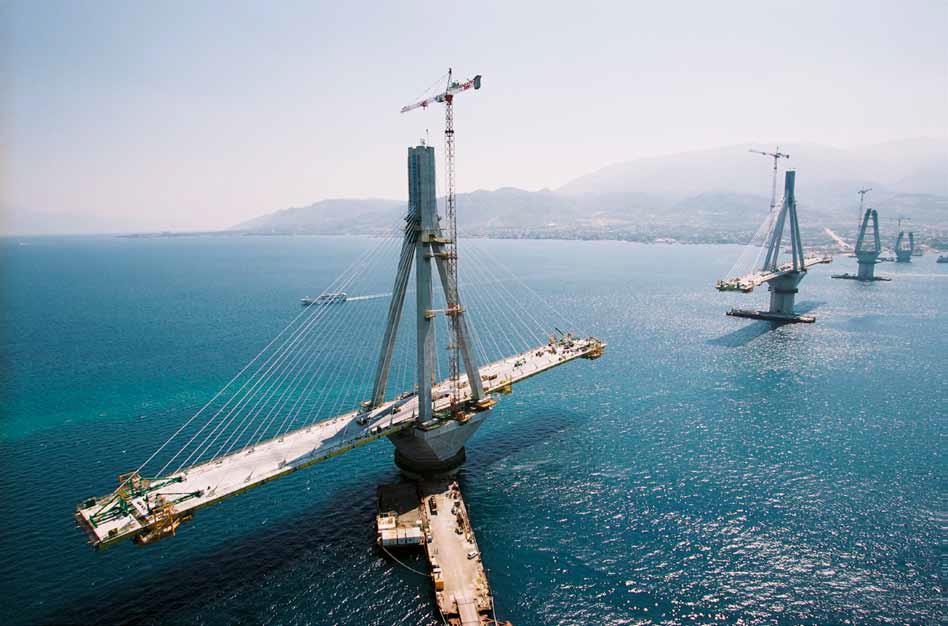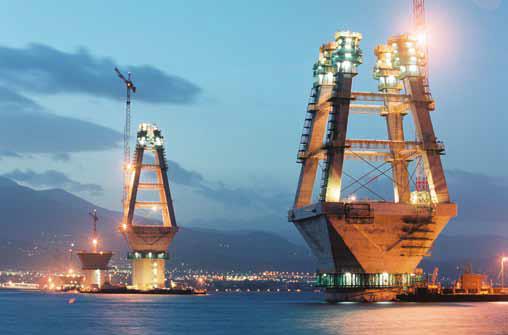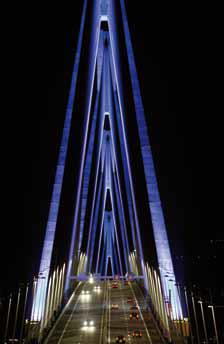

The idea of building a bridge across the Gulf of Corinth, between western Greece and the Peloponnese, was first envisaged in 1889 by Greece’s Prime Minister, Harilaos Trikoupis. But the difficulties inherent in the site are so great that it wasn’t possible to build this bridge, linking the towns of Rion and Antirion, until a century later.
The site’s enormous constraints
A million years ago, the Peloponnese broke away from the continent and drifted southward, creating the Gulf of Corinth. Located at the meeting of two tectonic plates, the gulf is one of the most seismic zones in Europe: the Peloponnese is still widening at a rate of several millimetres a year. Since 1965, there have been ten or so earthquakes in the region measuring more than 6 on the Richter scale. As a result, the bridge’s piers had to be designed to resist not only major earthquakes but also absorb movements of the tectonic plates up to 2 metres in any directions.

Rion-Antirion Bridge Shipyard, Greece
© Gefyra - N. Daniilidis
Realization of the foundations of the Rion-Antirion bridge
© Gefyra
Presentation
The seabed is up to 65 metres deep. Soundings to a depth of 100 metres from a specially equipped barge found only soft strata beneath composed mainly of alluvial deposits, sand and clay.
The bedrock lay at an estimated depth of 500 meters.
To build the foundations of a bridge 65 metres underwater.
In addition, the bedrock, at an unattainable depth, could not be used to anchor the foundations.
Innovative foundations
The combination of water depth and the composition of the seabed made the bridge’s conception extremely complex. No single soil reinforcement technique could be used to establish a base for the bridge’s foundations. The totally novel solution, after two years’ study involving models and laboratory tests, was a combination of exceptionally large superficial foundations and rigid inclusions reinforcing the terrain beneath.
At the base of each of the bridge’s piers, the gulf’s alluvial bed was reinforced with 150 steel tubes, 2 metres in diameter and 25 to 30 metres long, driven in vertically. They were topped by a 3 metre-thick layer of gravel, which supports the bases of the piers and absorbs movement during a major earthquake.

© Gefyra - N. Daniilidis
The base of each pier, 90 metres in diameter and 13 metres high, was built in a dry dock then tugged into a wet dock, where, as construction continued, it sank deeper into the water. When its immersed height was reached, the pile was tugged to its final position where its construction was completed.
A challenge to earthquakes
© Gefyra
The “tension-leg” barge
How to drive steel tubes at 7-metre intervals into a precise area of the seabed, then pour and level a layer of gravel at a depth of 65 metres ? These marine operations, vital for the construction of the bridge’s foundations, required purpose-built equipment, inspired by a technique used for offshore oilrigs: the “tension-leg” barge, a flat-bottomed boat anchored by weights on the seabed. The tension on the anchor lines gives the barge the necessary stability, despite the swell and current.
The bridge’s construction
When the four pylons were built, the bridge’s deck was assembled element by element. Given the seismic risks, the 2,252 metre-long deck is entirely cable-stayed by 368 metal cables. Therefore it doesn’t rest on the piles and can easily bend without breaking during an earthquake.
Les records du pont Rion-Antirion
- The highest submerged height of a pile: 65 metres.
- The largest bases: 90 metres in diameter.

© Gefyra - N. Daniilidis